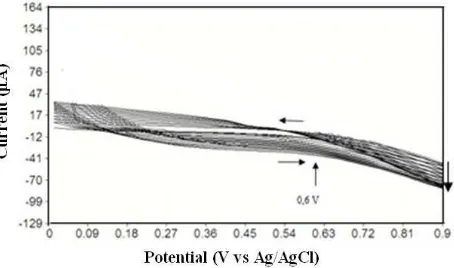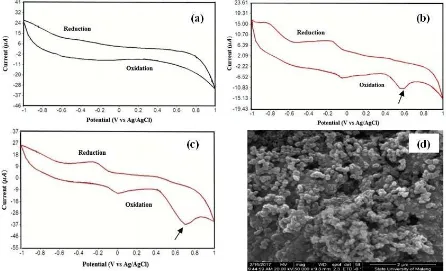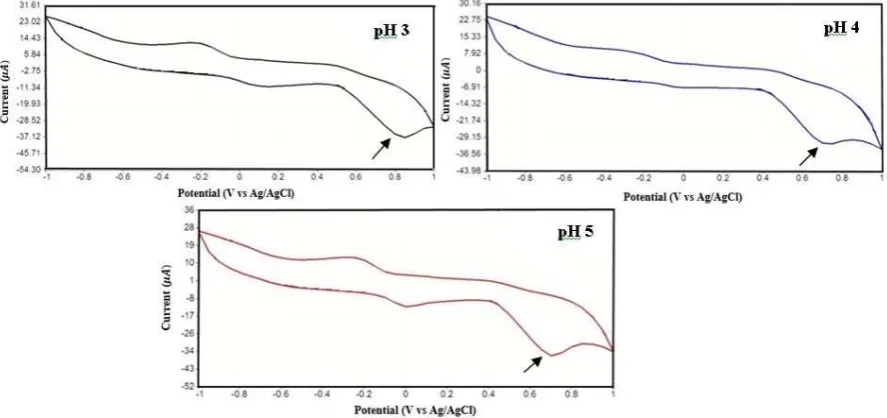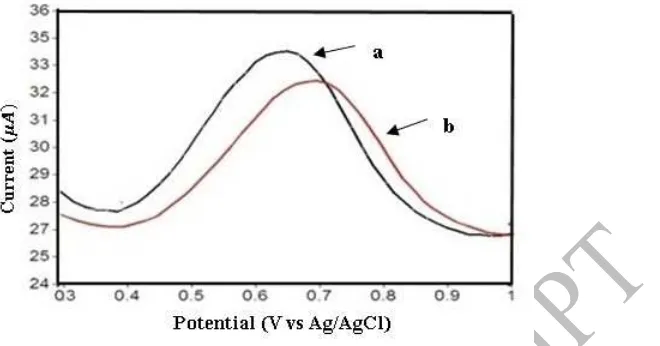The journal homepage www.jpacr.ub.ac.id p-ISSN : 2302 – 4690 | e-ISSN : 2541 – 0733
Modification of Screen Printed Carbon Electrode (SPCE) with
Polypyrrol (Ppy)-SiO
2for Phenol Determination
Erasti Pratiwi1, Ani Mulyasuryani1*, and Akhmad Sabarudin1
1
Department of Chemistry, Faculty of Mathematics and Natural Science, Brawijaya University
*
Corresponding email : [email protected]
Received day month year; Accepted day month year (will be given)
ABSTRACT
Modification of electrodes on a screen printed carbon electrode (SPCE) using polypyrrole (Ppy)-SiO2 has been successfully conducted for phenol determination. Modification of the electrode has been undertaken electropolymerization-wise using cyclic voltammetry. Electrode modification results are used to determine phenol using cyclic voltammetry and differential pulse voltammetry. In a cyclic voltammetry analysis, potential range of -1 to 1 V versus Ag/AgCl at scan rate of 100 mV/sec was used. Meanwhile, potential range of 0 to 1 V versus Ag/AgCl, scan rate of 50 mV/sec, pulse rate of 0.2 V, and pulse width of 50 ms were used in differential pulse voltammetry method. The results show that the increase in pH leads to a decrease in Epa potential peak and an increase in the current of phenol. Modified SPCE Ppy-SiO2 can be applied for phenol determination at a concentration of 103 -10-5 mM with sensitivity of 7.93 μA/mM.
Key word: Phenol, Polypyrrole-SiO2, Cyclic Voltammetry, Differential Pulse Voltammetry
INTRODUCTION
Phenol is a dangerous pollutant that is commonly found in water, canned food, air, and chemical products [1]. Excessive phenol can be dangerous and causes death to water organisms [2]. Based on the Regulation of State Minister of Environment number 03 of 2010, the maximum concentration of phenol allowed in waters is 1 mg/L [3]. Phenol has high toxicity and dissolves easily in water, so it is harmful to human’s health [1]. Therefore, it is necessary to establish a sensitive and accurate analysis method to control the content of phenol. Phenol is an electroactive compound that can undergo oxidation reaction, which can be analyzed using electrochemical method.
The electrochemical method of using modified electrodes has been attracting a great deal of attention because it has several advantages, such as it does not require complicated preparation, fast, and only requires very few samples [1]. Screen-printed electrode is an electrode device of working electrodes, comparative electrodes, and printed supporting electrodes, filled and coated on the surface of the substrate [4]. The surface modification of the electrode can be accomplished by adding various substances, such as metal oxides, polymers, and enzymes [5]. Various electrodes, such as PbO2-paste carbon electrodes,
enzyme-modified electrodes, and nafion-modified glassy carbon electrodes, have been extensively investigated for the determination of phenol oxidation [1].
with Np-CPE, Ag/AgCl as the compared electrode and Pt as the supporting electrode was used for the determination of phenol using cyclic voltammetry method [6]. In 2014, electrode modification used single-wall carbon nanotube (SWCNT)/GCE. The modified electrode was used for the determination of phenol using cyclic voltammetry and differential pulse voltammetry (DPV) [7]. In 2015, the modification of working electrode used Poly(3.4-ethylenedioxythiophen) immobilized in a single-wall carbon nanotube (SWCNT). The result of the modification was used for the determination of phenol using cyclic voltammetry and amperometry. The cyclic voltammetry method can provide a better way in controlling the growth of film polymer and avoiding over oxidation of phenol [8].
In this study, modification of electrode is done on screen printed carbon electrode (SPCE) with polypyrrole (Ppy)-SiO2 for phenol determination. Electrode modification with
polypyrrole (Ppy) has been widely applied in chemical sensors due to its high conductivity of 102 - 7.5 × 103 S/cm [9], its electrically conductive properties, its good mechanical properties [10], its easiness to be synthesized in water solvents, and its film thickness that can be controlled using electropolimerization process [11]. This study uses both polymers and oxide nanoparticles; one of them is silicon oxide (SiO2), acting as the supporting material and
oxidation catalyst in the process of phenol determination. SiO2 is used because of its ability to
cover a large surface area and its high adsorption power [12].
In this study, Ppy-SiO2 synthesis is done through direct electropolymerization on SPCE
working electrode with the cyclic voltammetry method. Electropolymerization with cyclic voltammetry is preferable because it can deposit the monomer of a Ppy film in the electrolyte solution on the electrode surface at the peak potential [10]. Therefore, the use of modified electrodes with Ppy-SiO2 is expected to increase phenol and electrode surface interaction, and
so does the oxidation peak with cyclic voltammetry method and differential pulse (IKAMAG®RH), oven (Memmert), glassware, micropipette (Accumax pro), Screen Printed Carbon Electrode (SPCE) BI 1302 (Quasense Inc.) consisting of carbon as the working electrode and auxiliary electrode, Ag/AgCl as the reference electrode, and potentiostat/galvanostat (Uniscan PG581) connected with computer and Scanning Electron Microscopy (SEM) FEI Inspect S50 and EDAX AMETEK.
The materials used in this study are ethanol, concentrated ammonia 25% (Merck), Tetraethylorthosilicate (TEOS) 99% (Sigma Aldrich), pyrrole 98% (Sigma-Aldrich), potassium chloride 99.5% (Merck), phenol 99% (Merck), acetic acid 99% (Merck), phosphoric acid 85% (Merck), sodium acetate 99% (Sigma-Aldrich), disodium hydrogen phosphate 99% (Merck), sodium dihydrogen phosphate 99% (Merck), sodium hydroxide 99% (Merck), and aquadem (Hydrobatt). All chemicals used in this study are of analytical
grade.
Preparation of SiO2 solution
Modification of SPCE with Ppy-SiO2 by Electropolymerization
In this study, the electropolymerization of pyrrole is carried out using cyclic voltammetry method on the SPCE surface with a working potential of 0 to 0.9 V and a scan rate of 100 mV/sec in 10 cycles [13]. The electropolymerization of the pyrrole is carried out in a 75 mM pyrrole solution, KCl 0.1 M in a water solvent, and 2.5 μL of SiO2 suspension is added. SPCE with Ppy-SiO2 modified is activated in 0.1 M NaOH solution using cyclic
voltammetry at a potential of 0 to 1.2 V in 10 cycles [14], and then it is washed with aquadem and dried at room temperature. Scanning Electron Microscopy (SEM) FEI Inspect S50 and EDAX AMETEK are used to determine the surface morphology of SPCE with Ppy-SiO2
modified.
Effect of pH
The effect of pH is determined using phenol solution in 1 mM acetate buffer solution (pH 3-5). Measurements are carried out using cyclic voltammetry in the potential range of -1 to 1 V toward Ag/AgCl, a scan rate of 100 mV/sec, and a current range of 100μA/V.
Determination of phenol with Differential Pulse Voltammetry (DPV) Method
SPCE with Ppy-SiO2 modified using electropolymerization is used for the measurement
of phenol solution in acetate buffer as the supporting electrolyte solution. Measurements are done using DPV method with the potential range of 0 to 1 V, pulse height of 0.2 V, scan rate of 50 mV/sec, and pulse width of 50 ms. Phenol measurements are performed at phenol concentration range of 10-3 -10-5 M.
RESULTS AND DISCUSSION
Electrode Modification Method with Ppy-SiO2
Ppy-SiO2 electropolymerization process using cyclic voltammetry is shown in Figure 1.
In the redox process during electropolymerization, three phases take place. The early phase is during the half-cycle at the beginning of polymerization, in which the potential starts from 0.6 to 0 V, which leads to neutral by releasing anion charge. In the second phase, the polymer reaches the top of oxidation with a re-diffusing anion to maintain its charge neutrality. The final phase is when it reaches the reduction potential and the anion is released. Usually, the second oxidation potential is higher than the monomer oxidation of Ppy layer on the electrode surface, but its density decreases [14]. In the pyro-electropolymerization process, the addition of SiO2 works as a support material to absorb phenol and to expand the effective surface of
the electrode. Polypyrrole (Ppy) on the SPCE surface can increase the conductivity of the electrode due to its characteristic of electric current conductor [10].
Phenol Characteristics of Ppy-SiO2 Modified Electrodes
The electrode-modified test is performed using cyclic voltammetry in a pH 5 acetate buffer solution and 1 mM phenol in a pH 5 acetate buffer in the potential range of -1 to 1 V and scan rate of 0.1 V/s. The test results of the modified electrodes are shown in Figure 2. The success of the modified electrode is identified from the electroactive properties that are shown by the phenol Epa value.
Figure 2. Cyclic Voltammogram on SPCE with (a) 0.1 M acetate buffer solution pH 5.(b) 1mM phenol solution in 0.1 M acetate buffer pH 5 without modification. (c) 1mM phenol solution in 0.1 M acetate buffer pH 5 modified by Ppy-SiO2. (c) SEM image of SPCE modified by Ppy-SiO2
According to Figure 2, the test voltammogram result using the acetate buffer solution shows that there is no oxidation or reduction peak, while the voltammogram test of 1 mM
phenol solution in acetate buffer on SPCE and SPCE pPy-SiO2 modified produces a phenol
peak current response in a modified SPCE pPy-SiO2 is higher than SPCE without
modification. This indicates that the electrode modified by Ppy-SiO2 can increase the
effective surface area of the coated electrode and can detect phenol. Moreover, the addition of Ppy-SiO2 on the electrode surface will lead to high sensitivity of the working electrode and
tend to enhance the resulting current. This result is accordance with the SEM image which depicted the spherical surface morphology that shows the morphology of Ppy-SiO2 [15].
Effect of pH
Based on cyclic voltammogram in Figure 3, it can be seen that the pH has an effect on Epa and Ipa. The effect of pH on peak current indicates that the increase of pH causes the
the data, it can be seen that the increase in Ipa can cause Epa shift, which progressively shifts
towards negative as the pH rises.
Figure 3. Cyclic Voltammetry of 1 mM phenol in 0.1 M acetate buffer solution with pH variation
Table 1. Measurements of modified electrode of 1mM phenol using cyclic voltammetry with pH variation
pH Average of Epa (V) Average of Ipa (µA)
3 0.75 10.13
4 0.70 11.33
5 0.68 13.16
The comparison is done using DPV method. The DPV signal comparison shows the peak current response of the 1 mM phenol that uses SPCE modified polypyrrole-SiO2. The
DPV method can increase the sensitivity and measurement limits detection by minimizing non-faraday currents. In this technique, the potential remains applied on the electrode surface. Table 2 shows that increasing pH makes the peak current increase as well. Thus, modification of SPCE with polypyrrole-SiO2 can decrease the potential and increase the oxidation current
of phenol.
Table 2. Measurements of modified electrodes to the 1 Mm phenol using DPV with pH variation
pH Average of Epa (V) Average of Ipa (µA)
3 0.75 2.49
4 0.69 2.95
5 0.65 3.47
Determination of Phenol using DPV Method
Figure 4. DPV voltammogram with 1 mM phenol in (a) 0.1 M acetate buffer pH 5, (b) phosphate buffer 0.1 M pH 5
Based on Figure 4, both of voltammograms show peak potential at 0.6 V range. The resulted peak current has a difference, in which the acetate buffer produces a peak of 3.34
μA, while the phosphate buffer yields a lower peak current of 2.9 μA. This difference indicates the effect of supporting electrolyte on phenol measurement. This is due to the differences in conductivity based on the electrolyte composition of the supporting electrolyte solution. The conductivity of acetate buffer is 0.111 S-cm2/mole, while that of the phosphate buffer is 0.03 S-cm2/mole. Thus, the modification of SPCE with Polypyrrole-SiO2 in acetate
buffer can increase the oxidation current of phenol.
Based on the result of phenol measurement in acetate buffer, the greater the concentration of phenol contained in the solution, the larger the current becomes. This is because the phenol concentration is directly proportional to the resulting phenol peak current. The determination of phenol is performed using DPV method in the potential range of 0 to 1 V, scan rate of 50 mV/sec, pulse height of 0.2 V, and pulse width of 50 ms. Based on Figure 5, the linear regression equation of phenol concentration to phenol peak height can be expressed as follows:
Ip (phenol) = 7.93[phenol] + 1.41
Based on the above equation, the sensitivity of phenol sensor is 7.93 μA/mM.
CONCLUSION
Modification of screen printed electrode (SPCE) with Ppy-SiO2 can be accomplished
using electropolymerized method. The effect of pH on a modified electrode can produce a peak current, along with the increase of pH. Electrode modification results that can be used for the determination of phenol using cyclic voltammetry as well as differential pulse voltammetry. The result of phenol measurement in pH 5 acetate buffer has a sensitivity value of 7.93 μA/mM.
REFERENCES
[1] Mojovic, Z., Jovic-Jovicic, N., and Bankovic, P. Elektrooxidation of phenol on Different organo Bentonite-Based Elecetrodes, Thesis, Universty of Belgrade, Serbia,
[2] Dewilda, Y., R. Afrianita and F. F., Jurnal Teknik Lingkungan, 2012, 9, 59-73.
[3] Republik Indonesia, Peraturan Pemerintah Republik Indonesia Nomor 3 Tahun 2010 Baku Mutu Air Limbah Bagi Kawasan Industri, 18 Januari 2010, Lembaran Negara Republik Indonesia Tahun 2010 Nomor 3, Jakarta, 2001.
[4] Z. Yueming, W. Haiyun, Y. Wei, C. Chuanjin., and W. Xiaowen, Sensors, 2013, 13, 8551-8563.
[5] Renedo, O. D., Alonso-Lomillo, M.A. dan Martinez, M.J.A., Talanta, 2007, 73, 202-219.
[6] Electronic, L., Of, J., Universit, C. A. and Slimane, S. Practices and Technologies, 2014, 166-178.
[7] Alemu, H., Negash, N.,Tessema, M. and Al, E. T. Anal. Chem.,2014, 5, 188–198. [8] Negash, N., Alemu, H. and Tessema, M., International Scholarly Research Notices
2015, 2015, 1-11
[9] Kim, B. C. The Synthesis and Characterisation of Hydrogel and Polypyrrole Blends.
Thesis, University of Wollongong, 1999.
[10] Sadki, S., Schottland, P., Brodiec, N., and Sabouraud, G. Chem Soc Rev, 2000, 29, 283–293.
[11] Kamalzadeha, Z., and Shahrokhiana, S. Bioelectrochemistry, 2014, 98, 1–10.
[12] Z. Min, Y. Wu, X. Feng, X. He, L. Chen and Y. Zhang. J. Mater. Chem., 2010, 20, 5835-5842.
[13] A. mulyasuryani, Ngibad, K. and Mardiana, D. Alchemy, 2016, 12, 36-49. [14] A Wanekaya, O. A. Sadik, J. Electroanal. Chem., 2002, 537, 135–43.



